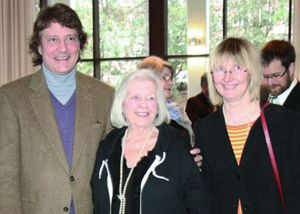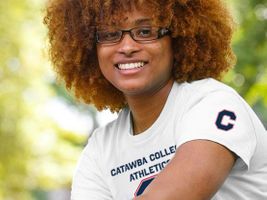
A Valentine’s Day concert provided a warm and stimulating reprieve from the cold, gray sky and threats of snow as Catawba College, Salisbury, North Carolina presented an hour of music in the Omwake-Dearborn Chapel from one of its own distinguished graduates, Pauliina Isomäki. A native of Finland, she traveled to Salisbury for the event. Her music delighted a large and enthusiastic audience and demonstrated not only her own proficiency as a composer, but also the quality of the music department faculty and choir.
Pauliina had come to the United States in the early 1980’s, first on a two year Rotary Scholarship to Georgia’s Valdosta State University (then Valdosta State College) and on an Adrian L Shuford,Jr. grant, she finished the final two years of a four year music degree at Catawba College. She studied piano with Dorothy Lewis-Griffith, studied various other instruments and at the same time worked hard in her theory classes. She said it was in her first year of theory that she began to understand how music was created and she wanted to do that.
After returning home to Turku, Finland, Pauliina earned a master’s degree at the Äbo Akademi, and became a very prolific composer. Some months ago President Brien Lewis of Catawba College invited Isomäki back to celebrate her impressive works.
Her music incorporates tritones, clusters and dissonances in such a way as to express human emotions and sounds of nature. She is often influenced by early and medieval European composers as well as by the national folk music of Finland. She said recently that she is thankful for the extensive training in mathematics that she received before she left Finland for the United States, which is a great help with composition. An entire concert by a single composer is an unusual happening at Catawba College. Such a concert by one composer’s very new music would only be usual in the Merkin Hall type venue.
The program began with a work for organ and two trumpets, Alkusoitto “Kiitosvirret kirkkahimmat” with Phillip Burgess at the organ while trumpet players, Chris Fensom and Luke Boudreault, played from the back of the auditorium. Together the three sounded out a majestic work which incorporated a melody of the medieval Finnish hymn Aetas Carmen. Isomäki’s work had been composed for a concert in the medieval Turku Cathedral, which was noted for its bells. She told us in the program notes, “These chimes served as a unifying force in the country during the war with the Soviet Union, 1941-44, when they were transmitted over the Finnish Broadcasting Company to sound the noon hour.”
Next came Songs from Kanteletar (Finnish Folk Poetry), Muut ja minä (The Others and Me), sung by the Catawba College Singers, directed by Phillip Burgess, and Kun saisin Savosta naia (I wish I Could Marry [a Woman] from Savo) sung by the men’s ensemble, also directed by Burgess. The final work of the mixed chorus in Latin was the Kyrie, Gloria and Sanctus from Missa Sanctae Catharinae. (St. Catharine Mass). Burgess showed great expertise in working with and conducting these students, who learned to sing in Finnish and Swedish for the concert. Not only that, there are some outstanding voice instructors at the college who had already trained the students, vocally. Former Academic Dean Bill Christie the linguist coached the chorus in the correct Finnish sounds until Isomäki arrived. The result was absolutely stunning and totally professional. Perhaps the highlight of the afternoon.
The renowned soprano, Christina Pier, accompanied by Renee McCachren on the piano, presented four songs, Den väntande själen (The Expecting Soul), which ends with the words ”I have just one name for everything and it is love.” Nocturne, with the words “The Night held her breath, A rose was destroyed in my hands, It was so silent. It was as if the universe had taken its last sigh.” Stjärnora (The Stars) “Do not walk barefoot in the grass. My garden is full of star splinters” and Mot alla fyra vindar (Against All Four Winds) “I have a gate towards all four winds, I have a golden gate towards the East, for the love that never appears, I have a gate for the day and another for melancholy, I have a gate for the death, it is always open.” The words were by Edith Södergran (1892-1923), a Finnish poet who wrote in Swedish and who died of tuberculosis at an early age. Pier’s voice was perfect for these songs, and McCachren accompanied her with technical agility and sensitivity. Isomäki was the translator for all vocal works, as well as for the entire program.
Soon after receiving the commission from Music Department Chair David Fish to write a work “for Dorothy [Lewis-Griffith] to play,” Isomäki sailed with her family to a special island in the Finnish archipelago, on the Sea of Åland. This island had been purchased by the Swedish Baron Göran Akerhielm where he had built his summer home, and had surrounded it with beautiful gardens, fountains and sculptures. Upon his death, he willed the island back to Finland and it is now open to tourists. The most exciting sculpture on the highest rock of the island, the Greek god Hermes, holding the caduceus--a magic staff with two snakes wrapped around, stands with one foot on the wind of Zephyr, god of warm spring breezes, poised to fly away. The statue is a copy of Giovanni da Bologna’s sixteenth century original.
The statue of Hermes captivated the imagination of Isomäki and was the inspiration for the commissioned work, “Hermes of Källskär.” According to Isomäki’s program notes, “the first movement, Hermeksen näköala (The View of Hermes), describes the bare rocks of the coast and a view of the open sea in summer, with Hermes sometimes wrapped in mist but always full of life. In the harsh winter of the second movement, Hermes nukkuu talviunta (Hermes Hibernates), the birds have flown south, the sea has frozen, daylight is scarce, and Hermes must hibernate to survive the treacherous winds which literally destroy the island’s harbor every winter. The third movement, Saaren Henki (Spirit of the Island) portrays the merciless nature of the archipelago, which is always ready to mock and destroy any work of human hands. In the fourth movement, Hermes ja meri ( Hermes and the Sea), the dramatic struggle ends and nothing remains but the sound of the waves.”
The premiere of Källskärin Hermes (Hermes of Källskär) was performed by Chris Fensom, trumpet, Luke Boudreault, trumpet, Frank Merritt, horn, Chris Ferguson, trombone and Dorothy Lewis-Griffith, piano. [Pauliina Isomäki wrote the following paragraph] “The brilliancy of the brass quartet contrasted and cradled the refined sound of the grand piano, and very fine pianissimos were also heard from the brass section. Lewis-Griffith was able to show off her delicate and intelligent musicianship especially in the solo piano ending of the work. She mastered the architecture of the piece and gave it’s ending a profound metaphorical meaning with the sound of the waves, fading away into eternity.”
During the reception for Isomäki which followed the concert in the Peeler Crystal Lounge, several people expressed a strong desire to see Finland, especially Hermes on the Island of Källskär.
In retrospect, the afternoon was a delightful and educational experience. Isomäki’s works were challenging and thoughtful; the performances by the various musicians exciting; the gravitas of the compositions was not only a tribute to the composer, but to Catawba College, both for its role in her education and for the professionalism on Sunday of its faculty, staff and students. It was a great success.
